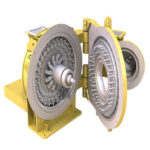Flow characteristics are dependent on several variables, including interparticle friction, particle shape and size, type of material, environmental factors, and weight of the bulk.
Characteristics of powder surfaces, such as surface oxide films and lubricant films, also affect flow characteristics. The presence of oxide films on powder particle surfaces alters the friction between particles and increases flow rate. Powders with lower surface oxide contents flow more slowly than powders with higher oxide levels. Minute additions of lubricants may increase the flow rates of metal powder, but further additions will reduce flow rates. For practical purposes, the higher the lubricant level, the slower the Hall flow rate (see Table 6).
In general, reduced flow rates are encountered with powders that exhibit one or more of the following characteristics: low specific gravity, low apparent density, high friction coefficient of fine particles, high specific surface area, a complex blend of different materials, and high moisture content.
Interparticle Friction. The resistance to flow depends primarily on the regions in which one particle hampers the free movement of other particles, either by direct contact or indirectly. This is mainly determined by the coefficient of interparticle friction. Particles may be prevented from moving separately by temporary adherence or interlocking. In this manner, clusters are formed that may occupy considerable volume. The phenomenon of cluster formation depends on the movement and type of powder, the flow varying markedly with the size and structure of the particles. If the particles were all truly spherical, they would generally roll readily into a die cavity. This can rarely be achieved in commercial powders; differences in size and shape are unavoidable.
Particle Size and Shape. Subsieve powders, those with particle sizes less than 44 /Jm, generally have poor flow rates. For this and other reasons, very fine powders are not used for compacts that are pressed on automatic presses. The particles of most powders used for compacting have irregular equiaxed shape, with flow rates between those of spherical (high flow rates) and flaky (low flow rates) powders.
Type of Material. Flow is influenced by the type of material, whether it be copper, aluminum, or iron. The major influence is the theoretical density. Other characteristics, such as adhesive and cohesive surface properties and magnetic or electrostatic interactions, are also factors.
Environmental Factors. Powders exposed to air containing high relative humidity absorb moisture on particle surfaces, resulting in reduced flow rate. On the other hand, as moisture content increases, many materials tend to agglomerate, which increases permeability and, consequently, increases discharge and settling rates. Seasonal changes in temperature do not affect the flow rate of metal powders considerably. Very low temperatures, however, can cause condensation of moisture; very high temperatures may partially melt the lubricants in the powder mix. Such extreme temperature conditions may cause interruptions in the flow of material through conveying systems. Also, because the permeability factor, K, is inversely proportional to the viscosity of the air or other gas in the void spaces, heating causes the gas to become more viscous, which makes the bulk solid less permeable.
Weight of the Bulk. A metal powder with a lower specific gravity, such as aluminum, generally exhibits slower flow rates compared to high specific gravity powders such as iron. At the same time, the higher the apparent density of a given material, the faster the flow. The ratio of apparent density to specific gravity can be used to correlate the bulk properties of various metal powders.


